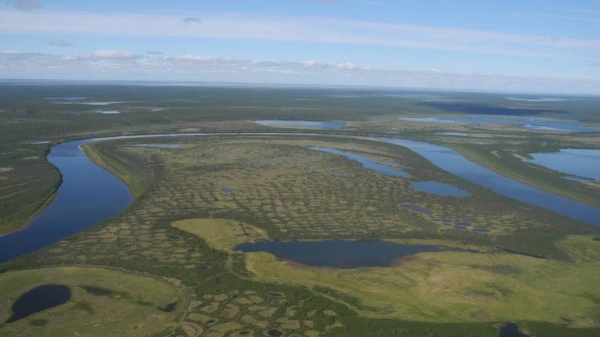Due to global warming, temperatures in the Arctic are climbing rapidly. As a result, the treeline for Siberian larch forests is steadily advancing to the north, gradually supplanting the broad expanses of tundra which are home to a unique mix of flora and fauna. Experts from the Alfred Wegener Institute have now prepared a computer simulation of how these woods could spread in the future, at the tundra’s expense. Their conclusion: only consistent climate protection measures will allow roughly 30 percent of the Siberian tundra to survive to mid-millennium. In all other, less favourable scenarios, the unique habitat is projected to disappear entirely. The study was just released in the journal eLife.
The climate crisis can especially be felt in the Arctic: in the High North, the average air temperature has risen by more than two degrees Celsius over the past 50 years – far more than anywhere else. And this trend will only continue. If ambitious greenhouse-gas reduction measures (Emissions Scenario RCP 2.6) are taken, the further warming of the Arctic through the end of the century could be limited to just below two degrees. According to model-based forecasts, if the emissions remain high (Scenario RCP 8.5), we could see a dramatic rise in the average summer temperatures in the Arctic – by up to 14 degrees Celsius over today’s norm by 2100.
“For the Arctic Ocean and the sea ice, the current and future warming will have serious consequences,” says Prof Ulrike Herzschuh, Head of the Polar Terrestrial Environmental Systems Division at the Alfred Wegener Institute, Helmholtz Centre for Polar and Marine Research (AWI). “But the environment on land will also change drastically. The broad expanses of tundra in Siberia and North America will be massively reduced, as the treeline, which is already slowly changing, rapidly advances northward in the near future. In the worst-case scenario, there will be virtually no tundra left by the middle of the millennium. In the course of our study, we simulated this process for the tundra in northeast Russia. The central question that concerned us was: which emissions path does humanity have to follow in order to preserve the tundra as a refuge for flora and fauna, as well its role for the cultures of indigenous peoples and their traditional ties to the environment?”
Read more at Alfred Wegener Institute, Helmholtz Centre for Polar and Marine Research
Image: Aerial photo of open Northern forest on the Taymyr Peninsula, Siberia, (proximity of the river Chatanga) consisting of larches. In some parts of this area the trees are growing in dense formations, in others one can see just very few trees. (Photo Credit: Stefan Kruse)


